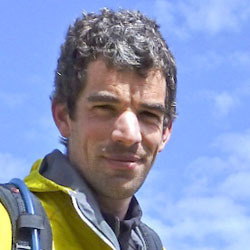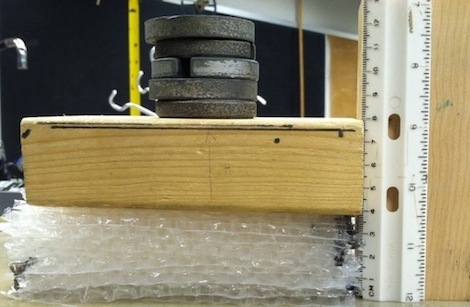Marc Abrahams's Blog, page 426
February 9, 2014
Rolled-up bits of paper in her head
On paper, human anatomy can seem simple, especially in books with titles such as Clinical Anatomy Made Ridiculously Simple. But…
Made of paper—quilled (rolled) paper—it most certainly is not. Not in the example here, anyway. The Collosal blog features some of the work of Lisa Nilsson, including this photo of one of her heads:
(Thanks to investigator Doug Roland for bringing this to our attention.)

February 8, 2014
Ig Nobel Conclave in Goa, India
 Five Ig Nobel winners travelled to Goa, India to explain how and why they have won their prize, at the Quark 2014 Techno Management Fest ‘Beyond Dimensions’ at the BITS Pilani K.K. Birla Goa Campus. On Sunday, February 9th 2014, their show starts at about 7pm local time in the auditorium. Try to be there (the theatre fits 2500 people) and meet:
Five Ig Nobel winners travelled to Goa, India to explain how and why they have won their prize, at the Quark 2014 Techno Management Fest ‘Beyond Dimensions’ at the BITS Pilani K.K. Birla Goa Campus. On Sunday, February 9th 2014, their show starts at about 7pm local time in the auditorium. Try to be there (the theatre fits 2500 people) and meet:
Dr Elena Bodnar (Ig Nobel Public Health Prize, 2009) explains why and how she invented a brassiere that, in an emergency, can be quickly converted into a pair of protective face masks, one for the brassiere wearer and one to be given to some needy bystander.
Professor Ilja van Beest (Ig Nobel Medicine Prize, 2010) talks about his discovery that symptoms of asthma can be treated with a roller-coaster ride.
Dan Meyer (Ig Nobel Medicine Prize, 2007) demonstrates the medical side effects of swallowing swords, and other unusual objects.
Kees Moeliker (Ig Nobel Biology Prize, 2003) talks about how his eyewitness report of the first case of homosexual necrophilia in the mallard (duck) changed his life.
Lal Bihari (Ig Nobel Peace Prize, 2003) tells how and why he led an active life even though he had been declared legally dead.
This Ig Nobel Conclave will be the first occasion in which Lal Bihari meets fellow Ig Nobel winners, because in 2003, for obvious reasons, he could not travel to the Ig Nobel Prize Ceremony. Now, ten years later, joined by four fellow Ig Nobel Prize winners, he will be presented his Ig Nobel certificate.

Fascinated by small cleavage
If you are fascinated by small cleavage, this report brings (or did, at the time it was published) exciting news:
“The resistance of diamond to abrasion,” E M Wilks and J Wilks, Journal of Physics D: Applied Physics, Volume 5 Number 10, 1972. The authors, at the University of Oxford, report:
“These experiments are a continuation of earlier work on the resistance of diamond to abrasion whilst being polished and ground. The most striking feature of the results is the very great difference in the resistance, or abrasion hardness, observed on the various faces for different directions of abrasion. A discussion of the variations shows that grinding and polishing generally proceed by a process of cleavage, on a microscopic scale.”

February 7, 2014
Murder, murder, murder in the UK, real and imagined
The number of murders on British television murder shows is to die for, if you are the sort that lives for that variety of entertainment. This study takes a narrow, sharp plunge into the relevant facts:
“Misrepresentation of UK homicide characteristics in popular culture,” J. Brown, N.S. Hughes, M.C. McGlen, and J.H.M. Crichton, Journal of Forensic and Legal Medicine, epub February 4, 2014. The authors are at Royal Edinburgh Hospital, explain:
 “The homicide statistics of a popular UK television fictional crime series and the former Lothian & Borders police force region, Scotland were compared…. 217 homicides were identified by 105 perpetrators in the television series ‘Midsomer Murders’ between 1997-2011; these were compared to 55 homicides by 53 perpetrators in the regional sample between 2006-2011. The numbers of serial killings (p< 0.0001), planned homicides, female perpetrators (pLothian & Borders cases were almost all single killings, mostly unplanned, with a far greater rate of homicide by kitchen knives ( p < 0.0001) and hitting/kicking (p = 0.0005) by intoxicated perpetrators.
“The homicide statistics of a popular UK television fictional crime series and the former Lothian & Borders police force region, Scotland were compared…. 217 homicides were identified by 105 perpetrators in the television series ‘Midsomer Murders’ between 1997-2011; these were compared to 55 homicides by 53 perpetrators in the regional sample between 2006-2011. The numbers of serial killings (p< 0.0001), planned homicides, female perpetrators (pLothian & Borders cases were almost all single killings, mostly unplanned, with a far greater rate of homicide by kitchen knives ( p < 0.0001) and hitting/kicking (p = 0.0005) by intoxicated perpetrators.
“Control of access to pointed kitchen knives by members of certain groups may reduce homicide rates…. If most UK homicides are impulsive, with perpetrators grabbing a convenient weapon to hand, simply impeding the access to a lethal weapon may reduce absolute homicide rates – in the same way that the change away from domestic coal gas and the restriction of paracetamol purchases has had an effect on suicide rates.”
(Thanks to investigator Ivan Oransky for bringing this to our attention.)

Success and the Attractive Bicycle Racer
Success is — to a measurable degree— in the eyes of the beholder, suggests this study of beautiful bicycle racers and not-as-beautiful bicycle racers:
 “A relationship between attractiveness and performance in professional cyclists,” Erik Postma [pictured here], Biology Letters, February 2014 vol. 10 no. 2. The author, at the University of Zurich, explains:
“A relationship between attractiveness and performance in professional cyclists,” Erik Postma [pictured here], Biology Letters, February 2014 vol. 10 no. 2. The author, at the University of Zurich, explains:
“Females often prefer to mate with high quality males, and one aspect of quality is physical performance. Although a preference for physically fitter males is therefore predicted, the relationship between attractiveness and performance has rarely been quantified. Here, I test for such a relationship in humans and ask whether variation in (endurance) performance is associated with variation in facial attractiveness within elite professional cyclists that finished the 2012 Tour de France. I show that riders that performed better were more attractive, and that this preference was strongest in women not using a hormonal contraceptive. Thereby, I show that, within this preselected but relatively homogeneous sample of the male population, facial attractiveness signals endurance performance.”
Bill Andrews gives his take on this, in Discover.
Postma is co-author of the possibly-related ”Genetic constraints underlying human reproductive timing in a pre-modern Swiss village,” A. Bürkli and E. Postma, Evolution,vol. 68, no. 2, pp. 526–537, February 2014.
(Thanks to investigator Steve Nadis for bringing this to our attention. )

The Greedy Bastard’s Guide to Business
 Morris B. Holbrook, who is the William T. Dillard Professor Emeritus of Business at Columbia University Business School, New York, has had 35-plus years of experience in teaching MBAs. This experience has enabled him, possibly prompted him, to author a new paper for the Journal of Macromarketing (December 2013, vol. 33, no. 4, pp. 369-385) entitled:
Morris B. Holbrook, who is the William T. Dillard Professor Emeritus of Business at Columbia University Business School, New York, has had 35-plus years of experience in teaching MBAs. This experience has enabled him, possibly prompted him, to author a new paper for the Journal of Macromarketing (December 2013, vol. 33, no. 4, pp. 369-385) entitled:
‘The Greedy Bastard’s Guide to Business’
“Greedy Bastards, eager to achieve success in the business world, need helpful advice on steps toward climbing to the top. Drawing on the author’s 35-plus years of experience in teaching MBAs, the present treatise offers tips in the form of a self-help tutorial intended as an inspirational guide. In that spirit, the discussion covers pertinent aspects of business education; impression management (Dre$$ for $ucce$$); tips from travel services; ethics; borderline-legal corruption; unintended benefits such as obesity, traffic, cell phones, and impacts on popular culture – culminating in a Greedy Bastard’s Honor Roll of Civic Achievements.”
Also see: ‘The 80 Minute MBA : Everything You’ll Never Learn at Business School’ (from Richard Reeves and John Knell, UK)

Jumping Off a Building With Bubble Wrap
Rhett Allain, writing in Wired, took a calculating approach to bubble wrap. He introduced it with these thoughts:
How much bubble wrap do you need to survive jumping out of the 6th floor of a building? Let me randomly say this is a height of 20 meters.
Where would you start with a question like this? Well, first, we need some bubble wrap. What properties can I even measure from bubble wrap?…
(Thanks to investigator Robert Lesco for bringing this to our attention.)

February 6, 2014
The diseased, skeptical (spinning?) eyes of Tasmania (1899)
These illustrations come from “Some of the Rarer Forms of Eye Disease,” G. H. Hogg, The Australasian Medical Gazette (July 20, 1899), vol. XVIII, no. 6, pp. 282-285. In A1, we see the distressing phenomenon in which a patient’s eyes turn into pinwheels and spin uncontrollably. In C, D, and E, the patient’s face adopts an appealing countenance of sardonic skepticism, which at least partially makes up for the pain and impaired vision.
Follow Amboceptor on Twitter: @AmboceptorBlog

February 5, 2014
The American Chemical Society’s improbable research webinar on Thursday (free)
Join us for a “webinar” about the Ig Nobel Prizes, Improbable Research, chemistry, and (best of all) lots of whatnot.
The American Chemical Society is hosting this webinar on their site, Thursday, February 6, from 2-3 pm US Eastern time.
It’s FREE for all, and may be something of a free-for-all, if all goes well.
A PHILOSOPHICAL NOTE: The ACS slogan, which you see here together with the ACS Logo, is “Chemistry for Life”. The ACS is being modest. Chemistry is much more enduring than that.

Causation, correlation, and gunshot wounds & blast injuries to the face
The loud insistence that “correlation does not imply causation” may have inspired this study:
“Gunshot wounds and blast injuries to the face are associated with significant morbidity and mortality: Results of an 11-year multi-institutional study of 720 patients,” Steven R. Shackford, et al., Journal of Trauma and Acute Care Surgery, vol. 76, no. 2, February 2014, pp. 347-352. The authors, at a variety of medical institutions in the USA, report:
“There are a number of limitations to this work…. Despite these limitations, we conclude that GSWBIFs [Gunshot Wounds and Blast Injuries to the Face] have high morbidity and mortality…. Further investigation is warranted.”
(Thanks to Bob Finn and John Fleck for bringing this to our attention.)
BONUS (vaguely related, maybe): A strange web site — stevenshackford.md.com — that asks “Are you Dr. Shackford?”

Marc Abrahams's Blog
- Marc Abrahams's profile
- 14 followers







